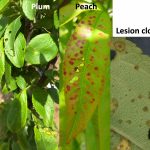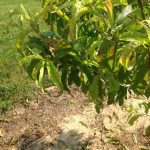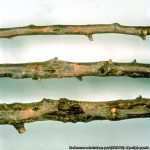Warm, wet weather has led to an uptick in bacterial shot hole disease, caused by the bacterium Xanthomonas arboricola pv. pruni (XAP). We started to see a significant uptick in shot hole on peaches, nectarine and plum before conditions turned dry. Leaves and fruit susceptibility to XAP infection decreases after pit hardening (if you were lucky enough to even have fruit this year). Keep in mind that any change to warm, wet weather can drive this disease.
Symptoms
Symptoms of this disease includes circular to irregular, water-soaked spots about 1 to 5 mm in diameter on leaves. Spots often turn red, purple or brown and can be seen surrounding the infected tissue along with surrounding healthy tissue. Eventually, the leaf spot will drop out, leaving a hole (Fig. 1). Leaves can have one to multiple shot holes and/or spots, and severely infected leaves may prematurely drop (Fig. 2). After the bacteria get into the leaves and begin to reproduce, symptoms develop. These symptoms usually appear between the leaf veins resulting in discrete, angular spots. Yellow or red halos often develop around the lesion. As lesions coalesce, the damage may appear more like blight, as opposed to a discrete spot
On fruit, dark brown or black spots sunken, cracked spots develop with a water-soaked margin (Fig. 3). These spots may be surrounded by a yellow halo. On cherry, fruit infection that occurs early in the season often results in distorted fruit; in peach and plum, larger spots may crack and ooze a combination of bacteria and gum. Peach scab is often confused for bacterial spot (Fig. 4) but will not have the oozing and gummosis.
In summer, other cankers may develop as dark water- soaked lesions around infected lenticels (Fig. 5). On twigs, gum may ooze from cracks when humidity is high and cracking or pitting may be observed between infected and healthy tissue. As these cankers increase in size, they become darker and sunken. As they expand and girdle the twig, dieback ensues. For apricot and plum, cankers persist and continue developing in younger (2- to 3-year-old) twigs and branches.
Laboratory diagnosis is necessary for confirmation of the bacterial pathogen; the fungal pathogen Wilsonomyces carpophilum also causes similar symptoms on leaves, as does copper phytotoxicity. Other bacterial pathogens, like Pseudomonas syringae, cause bacterial shoot blight and can also be confused with XAP.
Lifecycle
The bacterium persists and overwinters in small lesions and cankers on the twigs and branches. In the spring, bacteria ooze from the cankers and spread to additional branches or trees by wind-driven rain, insects, birds, and pruning tools. The bacteria infect via blossoms, lenticels and cracks on trees, and can easily infect through natural openings, wounds, and leaf scars. A weakened tree is much more prone to the infection than vigorous ones.
Bacteria are microscopic, single-celled microorganisms. Their lives are sort of boring: They take in nutrients, they grow, and when the get to a certain size, they split in two. This can happen in as little as 20 minutes, and twenty minutes later, those two daughter cells split into four, and twenty minutes later, those four are eight…and by the end of the day, the bacteria could have reproduced to a degree (272 = 4,722,366,482,869,645,213,696) that makes rabbits seem like underachievers. It is important to understand this level of bacterial growth for two reasons: 1) you realize that the bacteria are everywhere, even when you don’t see symptoms, and 2) they will become epidemic quickly when conditions meet their needs.
Bacteria enter through wounds, and natural openings in the plant, including stomata (microscopic openings on leaves). Once inside the plant, they produce toxins that kill cells, enzymes that turn cells into mush, hormones that make cells grow in odd ways, chemicals called effectors that suppress plant defense, or a type of slime (called exopolysaccharides) that block water conducting vessels. You might know this slime by another name—xanthum gum—a food additive used in salad dressings to thicken it, and make it stick to the leaves. Yum! These bacteria stick to plants as well as French dressing sticks to lettuce!
Even with a microscope, most plant infecting bacteria look surprisingly boring, like a pill–A very, very small pill. A key point to remember is that different species of Xanthomonas infects different plants, which is indicated by the term ‘pathovar’, meaning variety of bacteria pathogenic to one host. Xanthomonas arboricola pv. pruni infects stone fruit, whereas Xanthomonas vesicatoria infects tomatoes and peppers. So, if you have infected peaches, this pathogen will not spread to your tomatoes or peppers, but will spread between stone fruit. Keep in mind that conditions that favor any bacterial disease (warm, wet, humid conditions) pretty much favors them all.
Management
Regardless of which bacteria you are battling, there are certain key management strategies that reduce bacterial growth and spread. Bacterial diseases of the foliage are favored by prolonged periods of leaf wetness, and high relative humidity. Due to bacterial reproduction, they are everywhere, including all over asymptomatic plants. With a stressed or injured host, and wet conditions, splashing water easily spreads bacteria to overlapping and nearby plants. These bacteria then enter the leaf through injuries and natural openings, with water facilitating spread and infection. Thus, the longer the plants are wet, the greater the opportunity there is for infection to occur, and the more you handle or work around plants, the more likely they will end up damaged.
Susceptibility to this pathogen varies between species of stone fruits and varieties (Table 1). Some varieties react to infection with necrotic leaf spots, yellow halos and yellow leaf tips, and others may exhibit only necrotic leaf spots. Varieties with greater fruit resistance may show only slight skin-flecking.
Table 1. Reportedly XAP resistant and susceptible varieties.
| Fruit | Resistant Cultivar | Avoid (Susceptible) |
| Peach | Belle of Georgia, Biscoe, Bounty, Candor, Comanche, Contender, Desiree, Garnet Beauty, Harbrite, Harken, Late Sunhaven, Loring, Madison, Norman, Pekin, Raritan Rose, Redhaven, Redskin and Sunhaven | Babygold S, Blake, Elberta, Halehaven, Jersey Queen, Jerseyland, July Elberta, J.H. Hale, Kalhaven, Rio-Oso-Gem, Suncling, Suncrest, Sunhigh.
|
| Plum, European | Bradshaw, Bruce, Green Gage President, Robusto, Segundo, 98 Rubysweet, Shropshire, Yellow Gage;
Blue Damson |
Abundance, Formosa, Frontier, |
| Plum, Japanese | Black Amber, Early Golden, Queen Rosa, Ruby Queen, Satstuma, Shiro*, Wickson | |
| Nectarine | Avalon, Brigantine, Silver Gem | Easternglo, Sunglo, Flavortop, Redgold, |
Cultural practice is very critical to reduce the severity of the disease. Always avoid overhead irrigation to reduce transmission of the disease between branches or trees. If a new tree is scheduled to be planted, avoid planting it adjacent to a diseased tree.
Control of shot hole disease is not easily achieved through chemical sprays. The antibiotic oxytetracycline (Mycoshield or FireLine) provides good control when properly applied. For best results, use oxytetracycline at 12 oz. per 100 gals. of dilute spray. Use dilute or 2x; higher concentrates are not effective and may be phytotoxic. Spraying the entire tree once per week is essential. If you spray only one side of the tree (alternate row middle), make certain to spray the other side of the tree within 3-4 days.
Further protection against plant diseases can be provided by the use of copper-based pesticides. Copper is a multi-purpose biocide, capable of killing bacteria, water-molds and fungi—and damaging plants if care isn’t taken. When using copper, be sure to use non-acidified water to minimize the risk of phytotoxicity. Keep in mind that this is copper, and it is definitely not a ‘silver bullet’, or even a copper one! Copper sprays, applied for peach leaf curl at leaf drop, also may help control bacterial spot. Copper can also be applied until pit hardening to suppress outbreaks, with the rate of copper decreasing over the growing season. On peaches, copper can cause injury to leaves and appears as reddish spots and shot-holes with some very mild defoliation when using an effective rate of copper. In peach, the multiple (5+) copper applications for bacterial spot suppression makes it likely that the pathogen will evolve significant resistance to copper. There are no pesticides that will cure plants or provide perfect protection from bacterial diseases. Thus, prevention, suppression and eradication are key management strategies.
When pruning, any tools used to prune out cankers should be disinfected (bleach, trisodium phosphate, or commercial disinfectant).
For more information and excellent images, see: https://planthealthportal.defra.gov.uk/assets/factsheets/x-arboricola-pv-pruni-factsheet.pdf
And Learning from Peach Bacterial Spot Epidemics: Potential Strategies for Reducing Fruit Losses” (David Ritchie, North Carolina State University) at https://plantpathology.ces.ncsu.edu/wp-content/uploads/2013/06/Learning-from-Peach-Bacterial-Spot-Epidemics.pdf?fwd=no
- Figure 1. Bacterial shot hole symptoms. Photo by Janna Beckerman.
- Figure 2. Leaf spot and drop caused by XAP. Photo by Janna Beckerman
- Figure 3. Fruit infection by XAP. Photo by U. Mazzucchi, Istituto di Patologia Vegetale
- Figure 4. Peach scab is commonly confused with bacterial spot, especially when shot hole is present. Photo by Janna Beckerman.
- Figure 5. Cankering caused by XAP. Photo by U. Mazzucchi, Istituto di Patologia Vegetale.




